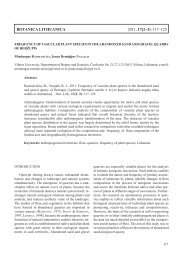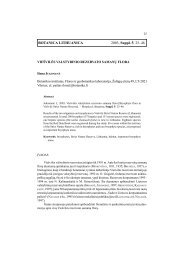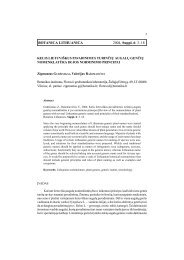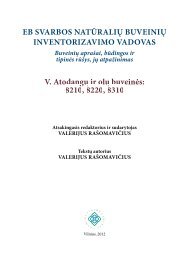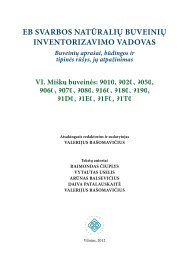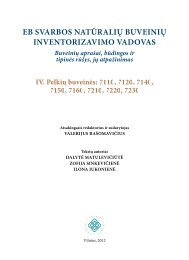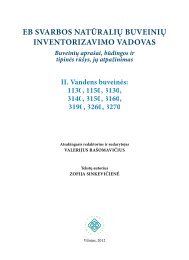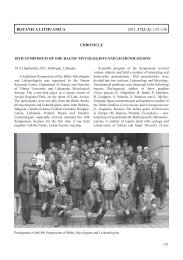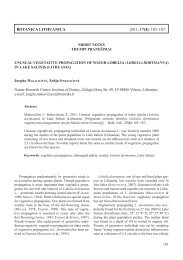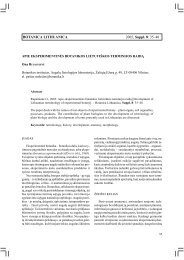FUNGI AND LICHENS IN THE BALTICS AND BEYOND XVIII ...
FUNGI AND LICHENS IN THE BALTICS AND BEYOND XVIII ...
FUNGI AND LICHENS IN THE BALTICS AND BEYOND XVIII ...
Create successful ePaper yourself
Turn your PDF publications into a flip-book with our unique Google optimized e-Paper software.
1. Disc surface waxy-looking – Belonia herculina, B. russula, Coenogonium luteum,<br />
C. pineti, Gyalecta foveolaris, G. geoica, G. liguriensis, G. peziza, G. schisticola, G. titovii,<br />
Pachyphiale carneola, P. fagicola, P. ophiospora.<br />
2. Disc surface without waxy cover. Paraphyse tips of different shapes are visible on<br />
the apothecia surface: 2.1. Capitate – Gyalecta flotovii, G. friesii, G. kukriensis, G. subclausa,<br />
G. truncigena, G. ulmi; 2.2. Reticulate – Gyalecta nigricans; 2.3. Crater-like – Gyalecta<br />
jenensis; 2.4. Linguiform – Gyalecta derivate.<br />
3. Disc surface with numerous crystals – Gyalecta leucaspis.<br />
<strong>THE</strong> PRELIM<strong>IN</strong>ARY RESULTS ON ANTIBACTERIAL ACTIVITY OF EXTRACTS<br />
FROM <strong>IN</strong> VITRO CULTURED MYCELIA OF Protoparmeliopsis muralis<br />
B. GUZOW-KRZEMIŃSKA 1 , J. DYBUŚĆ 2<br />
Department of Molecular Biology, University of Gdańsk, Kładki 24, 80-822 Gdańsk, Poland<br />
1 E-mail: beatagk@biotech.ug.gda.pl; 2 e-mail: czaprowska@wp.pl<br />
Lichens have been used in folk medicine for centuries. Many secondary metabolites<br />
have been identified and isolated from lichens and some of them were found to have<br />
antimicrobial activity. Although numerous studies were published on antibacterial activity of<br />
metabolites extracted from lichen thalli, mycelial cultures did not get that much attention so<br />
far. Antimicrobial activity of in vitro cultured mycelia of Protoparmeliopsis muralis (syn.<br />
Lecanora muralis) was tested against Gram-positive and Gram-negative bacteria. We tested<br />
acetone and methanol extracts from mycelia grown on PDA and GLBM media. The following<br />
bacterial strains were used in disc diffusion tests: Bacillus subtilis, Escherichia coli,<br />
Pseudomonas aeruginosa and Staphyllococcus aureus. We observed a stronger antibacterial<br />
activity against Gram-positive bacteria than Gram-negative strains.<br />
Acknowledgements. The study was financially supported by Marie Curie European<br />
Reintegration Grant within 7 th European Community Framework Programme project no.<br />
239343.<br />
<strong>LICHENS</strong> <strong>IN</strong> RED DATA BOOK OF LEN<strong>IN</strong>GRAD REGION – CURRENT<br />
SITUATION <strong>AND</strong> PERSPECTIVES<br />
D. E. HIMELBRANT, E. S. KUZNETSOVA,<br />
I. S. STEPANCHIKOVA<br />
Department of Botany, St. Petersburg State University, Universitetskaya Emb. 7/9, 199034 St.<br />
Petersburg, Russia<br />
Laboratory of Lichenology and Bryology, Komarov Botanical Institute of RAS, Prof. Popov<br />
Str. 2, 197376 St. Petersburg, Russia<br />
E-mails: d_brant@mail.ru, igel_kuzn@mail.ru, stepa_ir@mail.ru<br />
The first edition of Red Data Book (RDB) of Leningrad Region (LR) was published in<br />
2000. The list of lichens includes 49 species. At that moment it was about 7% of known<br />
lichen diversity in the region (Zavarzin et al., 1999). At present we have data about<br />
approximately 950 species inhabiting LR (e. g. Kuznetsova, 2007; Stepanchikova et al., 2009,<br />
2010). It means that only 5% of lichens are protected.<br />
The species were included in RDB according to the following criteria: 1) species listed<br />
in RDB of RSFSR (1988); 2) species that need protection throughout LR; 3) rare species



